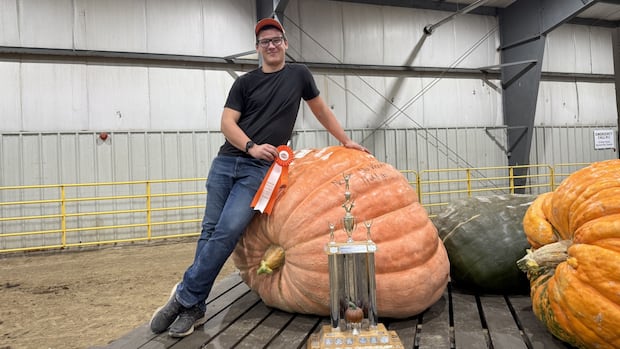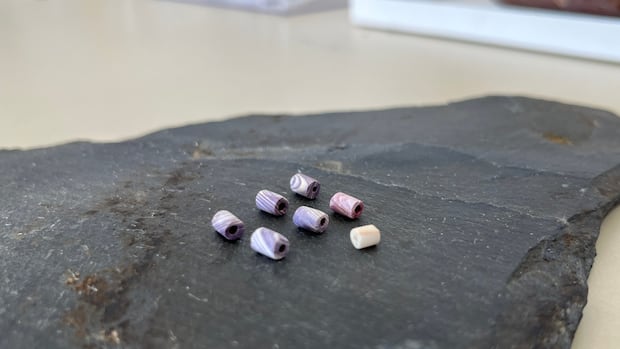Noah Devisser's massive pumpkin was growing at a rate of nearly 20 kilograms a day when he noticed tiny cracks opening on its surface — a potential death sentence for a gourd of its girth.
"The rate of growth required to get this big is very hard for the fruit to maintain without blowing itself apart," Devisser said.
So for a few days, he backed off his watering to slow the growth. The walls held.
His cautious cultivation early in the growing season paid off this Friday, when the pumpkin weighed in at a whopping 508 kilograms at the Spencerville Fair Mammoth Pumpkin Stake, enough to smash the previous 478-kilogram record.
"I don't think it matters how big you've ever grown before. Every time you get another big one, the biggest you've had, it's impressive," Devisser said.
 Noah Devisser, right, helps position his record-breaking pumpkin — which is suspended from a tractor — at the Spencerville Fair on Friday. His gourd took the fair's top prize, weighing in at a whopping 508 kilograms. (Emma Weller/CBC)Legacy of impressive gourds
Noah Devisser, right, helps position his record-breaking pumpkin — which is suspended from a tractor — at the Spencerville Fair on Friday. His gourd took the fair's top prize, weighing in at a whopping 508 kilograms. (Emma Weller/CBC)Legacy of impressive gourdsAt just 18 years old, Devisser hasn't been in the hobby for long. But part of his motivation for growing giant pumpkins is to help elevate the profile of a competitive tradition that traces its roots back nearly 200 years.
The early days of gargantuan gourds feature a cameo appearance of American naturalist Henry David Thoreau, who in 1857 stumbled upon the right seeds and soil to produce a pumpkin weighing more than 45 kilograms.
Although a pedestrian achievement by today's standards, it marked one of the first times a pumpkin of the "mammoth group" was grown in North America.
By the 1893 Chicago World's Fair, the heaviest pumpkin had reached over 150 kilograms, a record set by William Warnock of Goderich, Ont.
According to Devisser, however, modern competitive gardening only really took off in the 1980s, when another Canadian grower named Howard Dill crossed several mammoth varieties to produce the Atlantic Giant, from which today's giant pumpkins are descended.
"They've been doing this for years, and just growing bigger and bigger and bigger pumpkins," Devisser said.
"That's probably the number one thing — is you need to get seeds from the biggest in the world to grow the biggest."
In 2011, a squash expert at the New York Botanical Garden predicted the first one-ton (0.9-tonne) pumpkin would appear by 2014.
But just one year later, a massive gourd at the Topsfield Fair in Massachusetts achieved the feat ahead of schedule.
The current world benchmark has reached a staggering 1,247 kilograms, according to the website of record BigPumpkins.com.
But Devisser believes the top growers can push the number higher still, adding he expects to see a 1,300-kilogram pumpkin produced this year.
"I am not reaching the limit. I am nowhere near," he said.
 Devisser poses with his pumpkin. He says modern competitive gardening owes its start to another Canadian grower named Howard Dill. (Emma Weller/CBC)2nd life as chicken feed
Devisser poses with his pumpkin. He says modern competitive gardening owes its start to another Canadian grower named Howard Dill. (Emma Weller/CBC)2nd life as chicken feedAt the Spencerville Fair, Devisser's dad Brian was there to watch his son take home the top prize.
He followed his son into the hobby and said he's managed to outgrow him a few times — but not this year.
"I have a feeling I'll hear more about this for the next 12 months," he said.
Although giant pumpkins are edible, they're too watery to offer much flavour. Instead, once Devisser's record-breaking pumpkin has done the festival rounds, it will be used to feed the chickens.
"They can't eat the whole thing though," he said. "A lot of it will go sit in the compost pile for next year."











